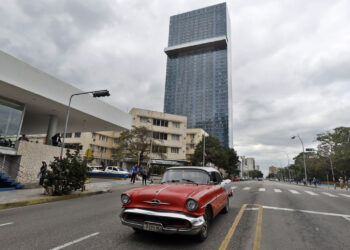The resident Cuban population at the end of 2018 was 11,209,628 and its distribution by sex says that 5,575,988 were men while 5,633,640 were women. [1] That year we were already less Cubans than in 2010, when the resident Cuban population was around 11,210,064.
The demographic alarms about the behavioral trends of the homo sapiens cubanus have gone off for quite some time.
These are generally long-term trends, so changing them is not a day’s task. Of course, as for the decrease of residents in the country, there’s the option of choosing to stimulate the immigration of other inhabitants from other regions of the planet, although in my personal preference I choose to do the impossible to keep the Cubans in their land.
Anyway, those 11,209,628, perhaps a little more, a little less, are the ones who are here and with whom we must push forward in that effort to make Cuba a prosperous, sustainable, independent and sovereign country.
Thus, getting all of them properly employed is decisive for that purpose. In other words, without Cubans employed where they can perform more according to their abilities, that task will become much more difficult, almost impossible.
That is why the meeting of the Ministry of Labor and Presidente Miguel Díaz-Canel’s address seemed so important for the present and future of the country.
Let’s first take a look at the data.
| 2019 | 2018 | |
| Total employees | 4,515,200 | 4,482,700 |
| Of them: state sector | 3,079,500 | 3,067,000 |
| in the budgeted system | 1,478,200 | nd |
| in the business system | 1,600,300 | nd |
| Non-state sector employees | 1,435,700 | 1,415,000 |
| Cooperative members | nd | 469,000 |
| Agricultural cooperatives | nd | 451 |
| Non-agricultural cooperatives | nd | 18,100 |
| Private | nd | 945,800 |
| Self-employed | 621,268 | 580,000 |
* All the data for 2018 come from Chapter 3 of the Statistical Yearbook of Cuba 2018. Meanwhile, the data for 2019 come from the information provided in Cubadebate in its report on the Annual Balance of the Ministry of Labor and Social Security published on January 18, 2020.
Although the 2019 data is not complete, combining both years we can approach the reality of employment in Cuba.
The data show some characteristics of the employment structure in Cuba that are of interest:
First, the preponderant weight falls on the state sector, which generates 60% of the country’s employment, while the non-state sector generates 31% of employment, confirming the importance of the former as a generator of employment.
Secondly, the weight of the budgeted sector within state employment that reaches 48% of the total employment generated in this sector is relevant, by 52% in the state business system.
In an underdeveloped country, with significant unmet growth needs, with notoriously low productivity levels, should this be the right proportion? Is it not necessary to achieve greater displacement of employees towards sectors that contribute directly to tradable production and services?
It is true that workers in education, health, science and culture are part of the budgeted sector, but without doubt there are still reservations to rationalize employment in this sector. Let’s go back to the data.
| Employees by sectors | % of total of employees | |
| Public Administration, defense and social security | 282,100 | 6.29% |
| Science and Technological Innovation | 26,400 | 0.59% |
| Education | 463,000 | 10.33% |
| Public Health and Social Assistance | 478,000 | 10.66% |
| Culture and Sports | 155,000 | 3.46% |
| Community, social and personal services | 352,400 | 7.86% |
| Commerce, repair of personal effects | 465,300 | 10.38% |
| Total | 2,222,200 | 49.57% |
The total number of employees in 2018 was 4,482,700 people. People employed in service sectors not directly associated with production reached almost 50% of total employees.
Public administration, defense and security and community, social and personal services employ 634,500 people, that is 13.15% of all employees in the country. It is true that, in public administration, defense and security, between 2016 and 2018 there was a decrease of more than 44,500 people, but will there be no possibilities to increase efficiency in those sectors and to be able to redirect a part of those people towards productive sectors?
While there was an increase of almost 82,000 people in Community Services, the same previous question fits here. It would also be necessary to generate incentives in the productive sector to induce this displacement and without a doubt one of the decisive, or the most decisive, is the salary.
Third, the combined data of the employment structure in 2018 and 2019 reveal that, although it is true that non-state employment was 31% of employment in 2018, if the comparison is made between the state business sector and the non-state sector, then the differences between the weight of the state business sector in total employment (35%) and that of the non-state sector (31%) are not too significant.
In other words, in the business sphere the employment generated by the state sector and the one generated by the non-state sector are very similar.
Fourth, it stands out that private employment, [3] according to 2018 data, reached 60% of employment in the state business sector and 21% of total employment in 2018, a not at all negligible proportion.
This means that, at least in terms of employment, it is also essential to achieve sufficient incentives for the non-state sector of the economy, cooperative and private, to grow, improve qualitatively and consolidate, as the data on the dynamics of production and the investment shows that the state business sector does not have sufficient capacity to generate a volume of employment capable of replacing the employment generated from the non-state sector. Nor is it possible to argue that the budgeted sector can fulfill that role.
Advancing towards 2030 along the path of development makes it necessary to include employment, its magnitude and quality, among the most important priorities.
Notes:
[1] All the above figures are taken from the Statistical Yearbook of Cuba 2018, Chapter 3, table 3.3.
[3] In the ONEI’s Chapter 3 of the Statistical Yearbook of Cuba it defines private workers as follows: “Private workers include, among others, private farmers, the self-employed, plastic artists, writers and other intelectual workers.”










